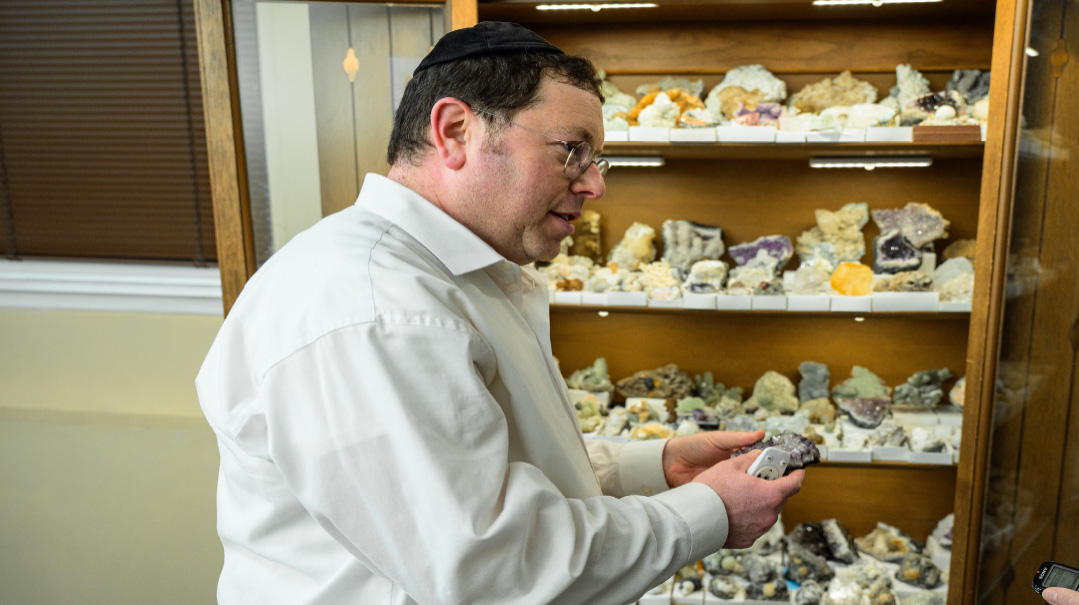Glass Act
| February 20, 2024Reb Ahron Hoberman embraces a unique, ageless art, finding deeper meaning amid a striking light show

Photos: Avi Gass
Stamped in Color
Young Ahron Hoberman scampered about near his father’s seat in shul, as little folks will do, while the venerable Rav Yaakov Kamenetsky ztz”l davened nearby. Reb Yaakov would come periodically to visit his son Reb Shmuel’s Philadephia Yeshivah, and was a familiar sight to Ahron, as his father, Rav Zev Hoberman, was a rebbi there at the time.
“Reb Yankef,” as he was affectionately known, had a soft spot for children, and he liked to knip Ahron’s cheeks, so Ahron felt pretty heimish with the prestigious Torah Vodaath Rosh Yeshivah and American Jewry’s spiritual guide.
It was Succos, and Reb Yaakov had brought his esrog to shul in his trademark style: in the original cardboard box it had been shipped in, with the postage stamps still stuck on. Ahron, who had a stamp collection, was immediately drawn to the colorful Israeli stamps.
Opting for the direct route, Ahron approached the gadol hador and asked him whether he could have the stamps on his box.
Reb Yaakov smiled widely and promptly agreed. Sure enough, on Motzaei Yom Tov there was a knock on the Hoberman door. A Kamenetsky grandson stood there, stamps in hand. Reb Yaakov had kept his word.
Today a grandfather himself and a creator of magnificent stained-glass art, Reb Ahron Hoberman credits his mother for encouraging him to sketch as a child and stimulating his interest in art, and he also vividly recalls this incident: “It was the first time I realized I was drawn to color. It was the exceptionally bright colors of the stamps — part of a series they were doing on sea life — that grabbed me. In fact, I can still vividly recall the images on those stamps today.”
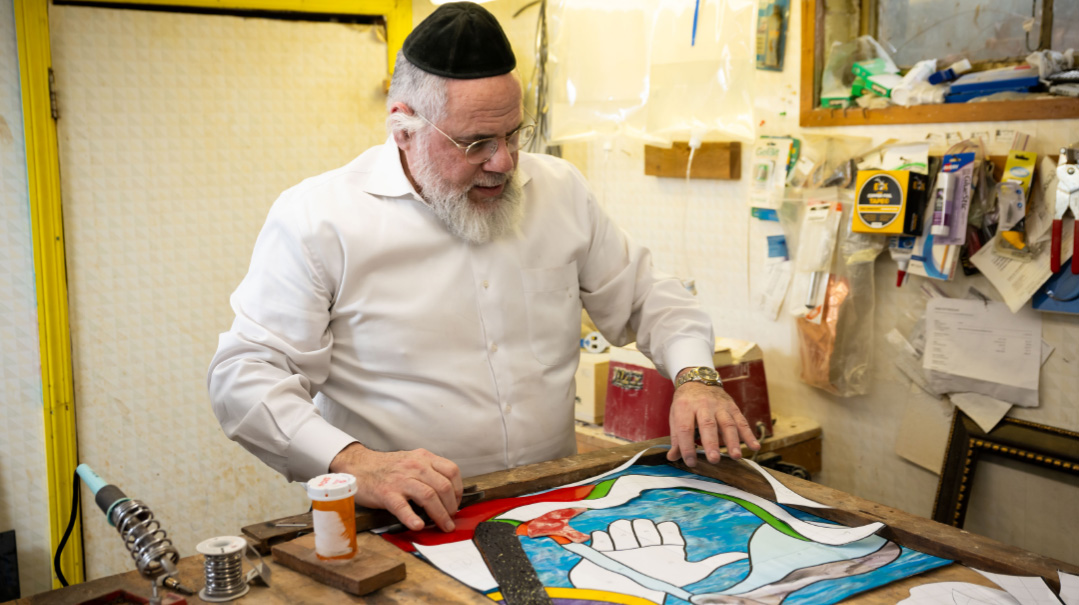
The Right Combination
Still, it would be a while before this propensity to art was actualized. In the meantime, Ahron grew up, learning in the yeshivos of Scranton, Adelphia (under Reb Meir Hershkowitz ztz”l), Stamford, and Lakewood, and raising his own family in the spirit of that world.
After marrying and learning in Beth Medrash Govoha’s kollel for some time, Reb Ahron — who was always good with his hands — began to work in construction, repairs, and property management, even building his own home. He later became a kashrus supervisor for NPGS grocery in Lakewood, a position he still holds today.
Reb Ahron actually built, in the employ of Zeev Rothschild z”l, the famous “trailers” beis medrash in BMG, which later became known as “Bais Eliyahu” (and was subsequently knocked down to make way for the “Bais Yitzchok” beis medrash). He was also involved in the construction of the Lakewood mikveh on 11th and Madison, among other projects.
Reb Ahron isn’t the only one in the family with artistic talent; several of his children wield paintbrushes like masters as well. In fact, he remembers how his own father once went out to buy wicks for Chanukah, and somehow came home with a beautiful $400 silver menorah. Now, his father was scraping by on a rebbi’s salary, but still, his appreciation for the mitzvah merged with his aesthetic sensitivity to compel him to go just that bit beyond.
About 15 years ago, with the encouragement of his wife and children, Reb Ahron decided to explore his own latent talent. At first, he toyed with woodworking, producing a few esrog cases and some other works. But eventually he decided to transition to glass. Creating stained glass art combines precise hands-on skills with art, so it seemed like just the thing for him.
Shopping around for an appropriate teacher from whom to learn the skill, he came across a set of instructional DVDs created by Mark Stine, a secular Jew and top-tier glass artist from Denver, Colorado. He went through the course until he felt he had a handle on the art.
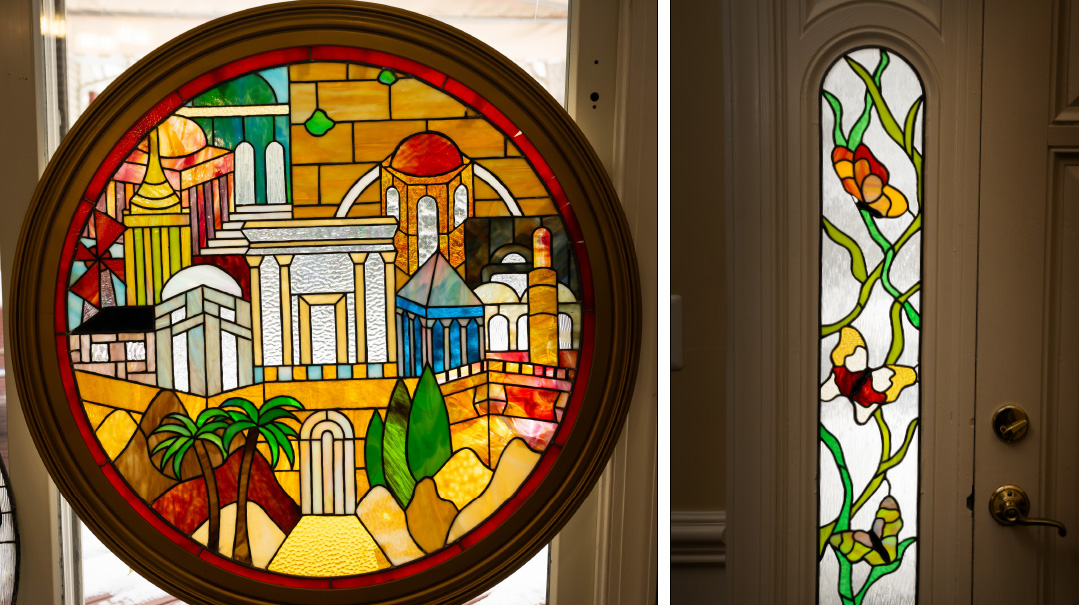
Precious Windows
As part of Reb Ahron’s kashrus job, he travels once a week from Lakewood to Baltimore (where NPGS does its shechting). He also gives a popular night seder shiur in “Friedman’s,” a local yeshivah, and writes and edits for various Torah-related projects. So when does he find time for his hobby?
Somehow, he does. While the world of Torah is his first priority, he says that if Hashem gives a person talent, it’s that person’s obligation to use that strength to serve Hashem. That’s why he’s drawn to Jewish themes, rather than just sticking to the stained glass classics such as butterflies, hot air balloons, and flowers. When he creates a work depicting the Beis Hamikdash, Simchas Beis Hashoeivah, or Yamim Tovim, it’s his way of using the medium for spiritual expression.
Maybe that’s why I have this drive to keep growing artistically,” he says. “Have I done my best? Can I do more? Because I see this as talent that HaKadosh Baruch Hu has given to me, and I always wonder whether I’ve done enough with that gift.”
He says that even in the last few weeks, he’s begun a new technique called “plating” which uses several layers of glass to produce a more complex look, both in color and texture.
“The point is to keep on growing,” he says. “Naturally, the same drive manifests in every piece as a need for more precision, perfectionism, and professionalism.”
While stained glass windows are often associated with churches, Reb Ahron says the concept is actually sourced in the Torah, and quotes the pasuk in Yeshayah (54:12-13) “V’samti kadkod shimshosayich… v’chol bonayich limudei Hashem — and I will make your windows of jasper and your borders of precious stones… and all your children will be disciples of Hashem….” In Rashi’s explanation on this pasuk, he says “shimshosayich” refers to the sun shining through colored panes.
Reb Ahron built some of his pieces into his own home, where they serve as windows, turning his home into a sort of art gallery. Other pieces are hanging on various walls, and still others are on display in his succah, giving it an exquisitely special aura, especially in the mornings when the sunlight streams though the brilliant colors of the many panes, creating a veritable color show.
Rabbi Hoberman’s studio is in his own home, and is admittedly quite small. While he does sell a piece here or there, right now his glasswork is more a hobby than a parnassah, and most people who have his work received the pieces as gifts. Looking to the future he hopes to one day transition the glasswork into a retirement enterprise of sorts. He’s thinking of selling to shuls, making stained glass windows great again, and is in the process of building a website from which to market his work.
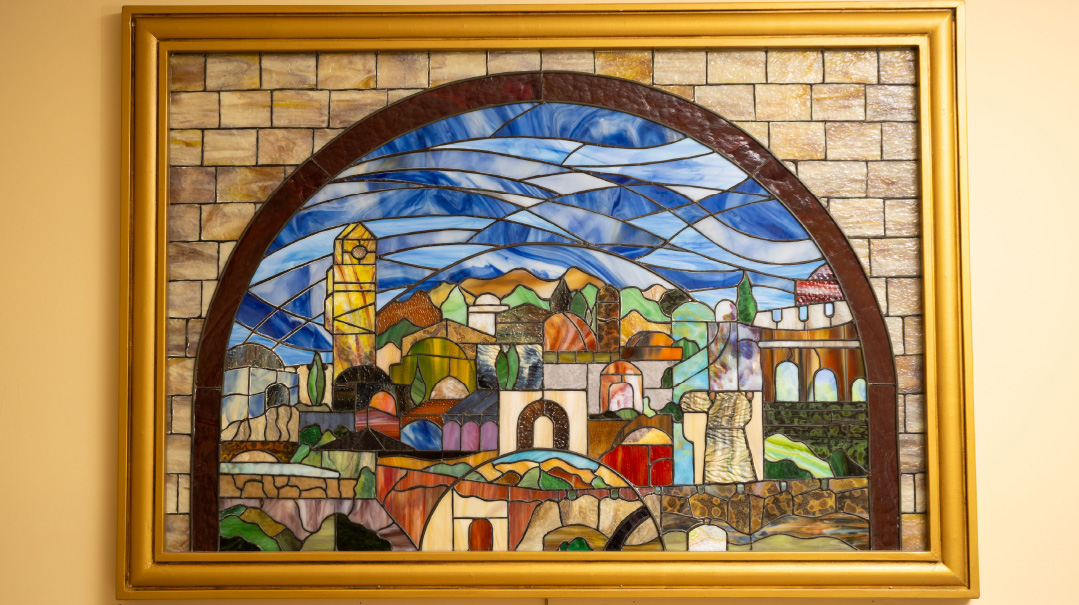
Shine the Light
Ahron Hoberman explains that there are a few ways of displaying stained glass art. The best way is when the sunlight shines through it. With this method, the piece will look different depending on the way the sun is shining (how early it is, how cloudy, etc.). If displaying the piece in sunlight isn’t practical, artificial light can be placed behind the glass instead. (Of course, the glass can simply be displayed as is, with no light source shining through it, just the colors of the darkened glass serving as the picture in and of itself — but some of the luster may get lost.)
Reb Ahron admits that when he finishes a work in his studio, he’s not really sure yet what it will look like in “real life” once it’s put in the sunlight. When he brings his piece out into the light, it’s the moment of truth for the many hours of work he put in. On the one hand, he feels the excitement of bringing the fruits of his labor to fruition. Yet it can also be a moment of disappointment, as the true colors of the piece become visible. If that happens, it’s back to the studio to make some changes.
“It’s what I call the ‘moment of birth.’ As this artwork is so dependent on natural light, there is only so far that imagination, experience, and artificial, electric lighting (even a specialized light box) can take you,” he says. “I’m never sure what the final result will be, nor if I will be satisfied with that final result until I bring the piece out of my workshop into natural light. Sometimes I take the piece outside before it’s totally finished because I just can’t wait. But I can say that I don’t recall any instance of it turning into a moment of horror.”
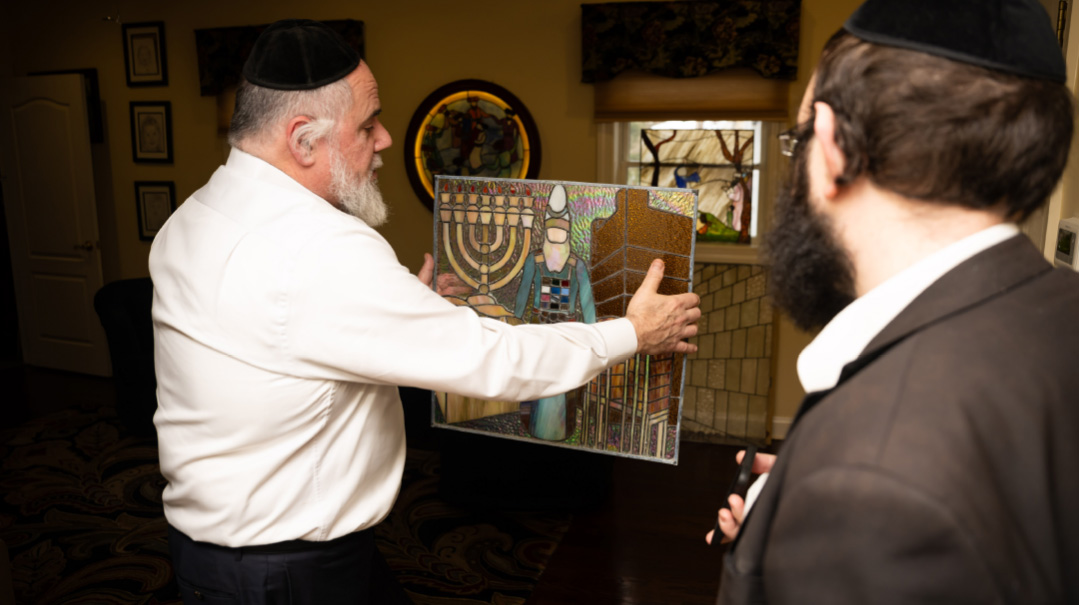
Start to Finish
Before any glass is cut or frame created, Reb Ahron brainstorms for ideas until he conceptualizes what he wants his piece to look like. He draws inspiration from lots of different artists, and his works follow several different genres within stained glass.
When he works on Jewish themes, Reb Ahron will do extensive research in order to create exact details and incorporate subtle symbolism as well.
In his Simchas Beis Hashoeivah piece, for example, the orange floor of the Beis Hamikdash illustrates the powerful light of the special oversized menorahs the Mishnah says illuminated the entire city of Jerusalem.
Once he’s settled on an idea, he uses a software program to create an outline of how the glass will look. He prints this out on paper, and it serves as his map.
Reb Ahron keeps himself well-supplied with sheets of specialized glass in as many shades and styles as he can. He orders some supplies online, but for the actual glass, he goes down to a local warehouse (there are two of these in New Jersey) specializing in this kind of glass. He says that a glass artist “needs to hold the glass in his hand and experience it. Sometimes I buy glass impulsively — not for a particular project but just because it grabs me. I guess you can call me addicted to beautiful glass.”
Once he settles on the glass he wants, he needs to cut it to size. He starts by cutting out sheets of paper corresponding to the shapes on his “map.” He then glues the paper to the back of the glass, so it will show him exactly where to cut. He runs a special cutting tool down the lines which need to be cut, although it doesn’t cut all the way through, but rather just creates a groove. He then breaks the piece off using a plier, along the groove lines. (Sometimes the glass needs to be ground down a bit more to fit exactly.) Once the piece it cut to size, he wraps in in lead or copper tape (he makes sure to wash his hands after touching the lead), and solders the ends together.
He repeats this process for every single pane — and some pieces have hundreds of individual panes.
Once everything is in place, he wraps it in a metal (zinc) frame and solders it closed. Then he coats the work with patina and wax for finish.
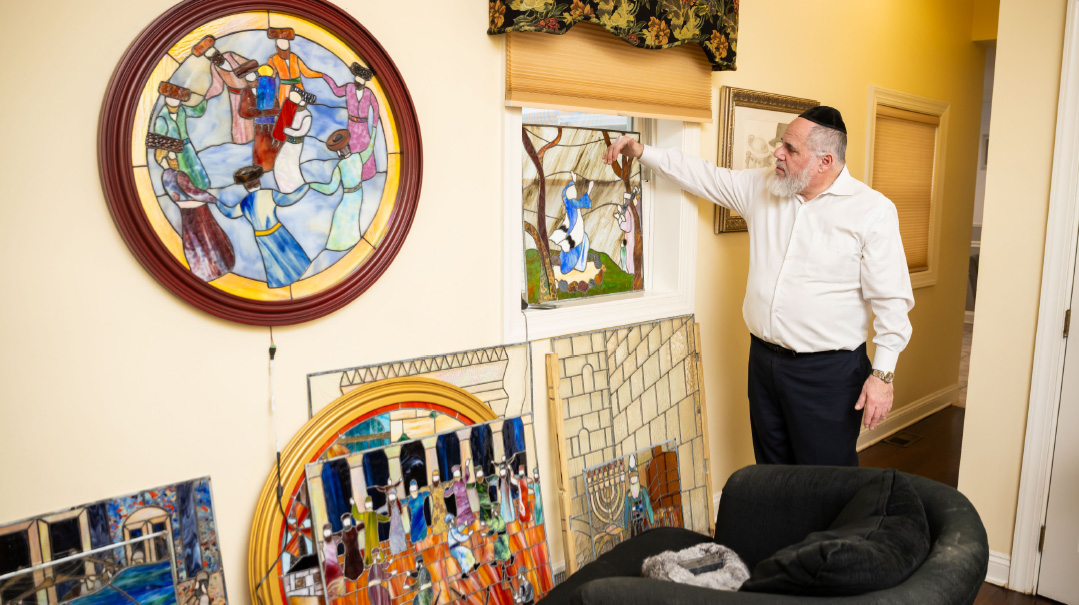
Reconnecting
While initially Ahron Hoberman had no direct contact with his teacher Mark Stine, one day he decided on a whim to reach out. He had some questions, and he wondered whether Mark would be open to helping. To his surprise, Mark, now in his seventies, was happy to give of his time, and the two are now regularly in touch. Stine, while not religious, takes pride in having a student who is a “rabbi,” and told Reb Ahron that he even keeps an image of his work as the screensaver on his computer.
Although he’s happy that Mark Stine thinks so highly of his work, Rabbi Hoberman himself can’t tell you that any one piece is a favorite.
“They’re all favorites, they’re all memorable,” he says. “I do this because I love the craft, and I don’t stop loving it when the piece is finished and has left the shop.”
Still, one work particularly draws him. “The Beis Hamikdash piece, which hangs in my succah, is built of all clear glasses, with the exception of the Beis Hamikdash building itself for which I chose a clear glass which is iridescent. This gives the piece a special magnetism, especially at night — it just glows with many different colors. I would say it’s in a “glass” of its own.
(Originally featured in Mishpacha, Issue 1000)
Oops! We could not locate your form.



